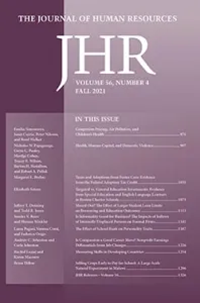Hassles and Environmental Health Screenings: Evidence from Lead Tests in Illinois
IF 6
1区 经济学
Q1 ECONOMICS
引用次数: 5
Abstract
Lead paint, a harmful environmental hazard, can still be found in millions of homes in the United States. Due to high inspection and clean-up costs, prevention programs target intervention to the relatively few homes where small children test positive for lead poisoning. Because children have to visit a doctor to get tested, only households willing to undergo this hassle self-select into screening. Is self-selection an effective targeting mechanism? I study screening take-up by analyzing geocoded 2001-2016 lead screening data on 2 million Illinois children. My empirical strategy exploits variation in travel costs due to healthcare providers’ openings and closings. I find that travel costs reduce screening among lowand high-risk households alike, without improving targeting. Consistent with low poisoning rates, high-risk households are only willing to pay $4-29 more than low-risk households for screening. Despite poor targeting, screening incentives may be cost-effective because of the externalities of lead exposure. ∗Department of Economics, University of Chicago. Email: lgazze@uchicago.edu. I am indebted to Michael Greenstone for his mentorship throughout my postdoctoral scholarship. Ali Abbasi, Marcella Alsan, Alex Bartik, Fiona Burlig, Thomas Covert, Catie Hausman, Michael Kofoed, David Meltzer, Rebecca Meyerson, Jack Mountjoy, Nick Sanders, Tommaso Sonno, Dan Waldinger, and seminar and conference participants at EPIC, Indiana University, Urban Labs, APPAM, ASHEcon, the H2D2 Research Day, and the 4th Marco Fanno Alumni Workshop provided helpful comments and suggestions. I am also extremely grateful to the staff at the Illinois Department of Public Health for sharing the data for this analysis as well as their insights and expertise in interpreting the results. The conclusions, opinions, and recommendations in this paper are not necessarily the conclusions, opinions, or recommendations of IDPH. This project would not have been possible without the generous support of the Joyce Foundation. Bridget Pals and Xiyue (Iris) Song provided excellent research assistance. All remaining errors are my own.麻烦和环境健康筛查:来自伊利诺伊州铅测试的证据
含铅涂料是一种有害的环境危害,在美国仍有数百万家庭使用。由于检查和清理费用高昂,预防方案的干预目标是相对较少的家庭,那里的小孩铅中毒检测呈阳性。因为孩子们必须去看医生进行检查,所以只有愿意经历这种麻烦的家庭自己选择进行筛查。自我选择是一种有效的靶向机制吗?我通过分析2001年至2016年伊利诺伊州200万儿童的地理编码铅筛查数据来研究筛查的接受情况。我的实证策略利用差旅成本的变化,由于医疗服务提供者的开放和关闭。我发现,旅行成本降低了低风险家庭和高风险家庭的筛查,却没有提高筛查的针对性。与低中毒率一致,高风险家庭只愿意比低风险家庭多支付4-29美元进行筛查。尽管目标不明确,但由于铅暴露的外部性,筛查激励措施可能具有成本效益。*芝加哥大学经济系。电子邮件:lgazze@uchicago.edu。我非常感谢Michael Greenstone在我获得博士后奖学金期间对我的指导。Ali Abbasi, Marcella Alsan, Alex Bartik, Fiona Burlig, Thomas Covert, Catie Hausman, Michael Kofoed, David Meltzer, Rebecca Meyerson, Jack Mountjoy, Nick Sanders, Tommaso Sonno, Dan Waldinger以及EPIC, Indiana University, Urban Labs, APPAM, ASHEcon, H2D2研究日和第四届Marco Fanno校友研讨会的研讨会和会议参与者提供了有用的意见和建议。我也非常感谢伊利诺斯州公共卫生部的工作人员分享了这一分析的数据,以及他们在解释结果方面的见解和专业知识。本文中的结论、意见和建议不一定是IDPH的结论、意见或建议。如果没有乔伊斯基金会的慷慨支持,这个项目是不可能完成的。Bridget Pals和Xiyue Song提供了出色的研究协助。所有剩下的错误都是我自己的。
本文章由计算机程序翻译,如有差异,请以英文原文为准。
求助全文
约1分钟内获得全文
求助全文
来源期刊

Journal of Human Resources
Multiple-
CiteScore
7.00
自引率
1.90%
发文量
53
期刊介绍:
The Journal of Human Resources is among the leading journals in empirical microeconomics. Intended for scholars, policy makers, and practitioners, each issue examines research in a variety of fields including labor economics, development economics, health economics, and the economics of education, discrimination, and retirement. Founded in 1965, the Journal of Human Resources features articles that make scientific contributions in research relevant to public policy practitioners.
 求助内容:
求助内容: 应助结果提醒方式:
应助结果提醒方式:


